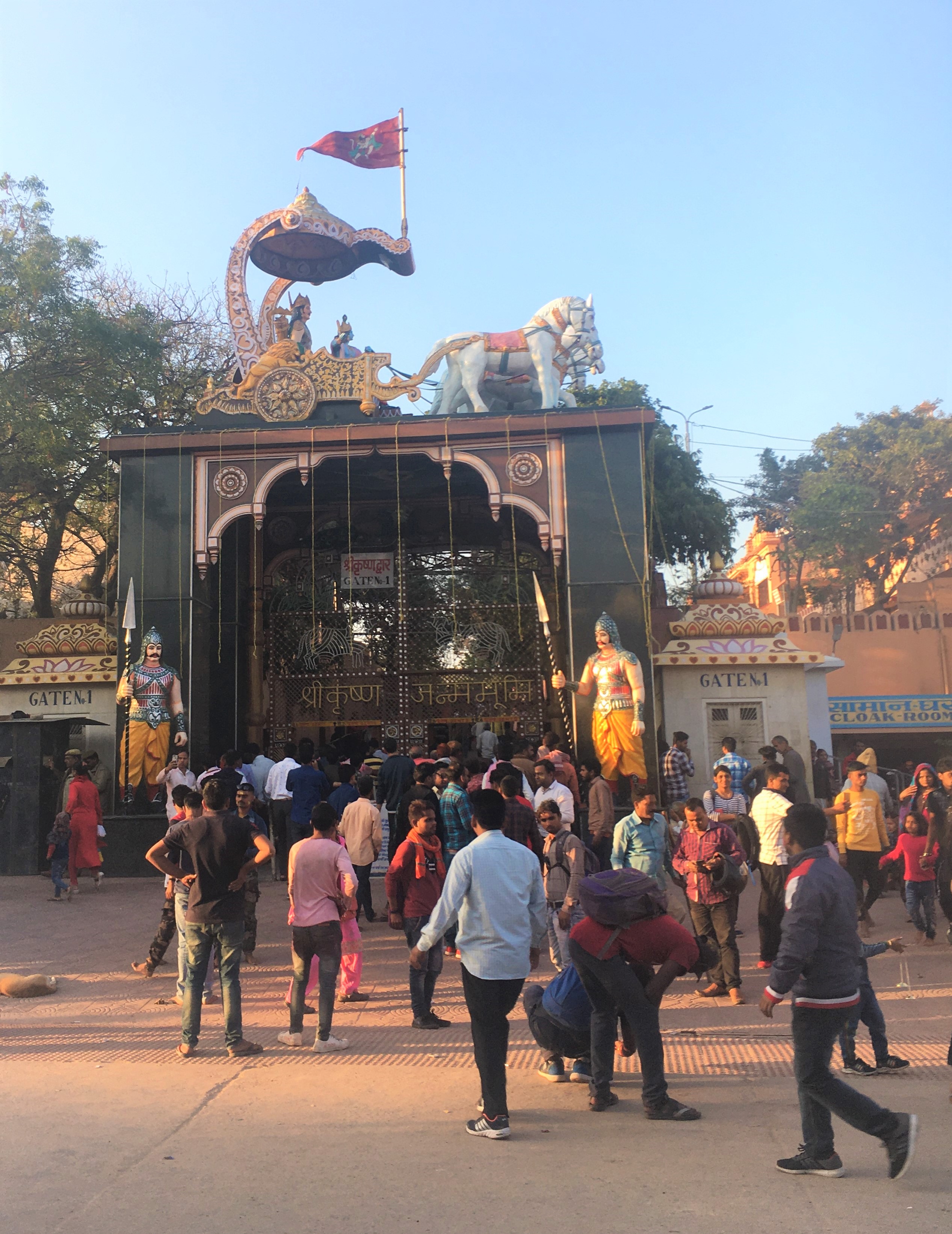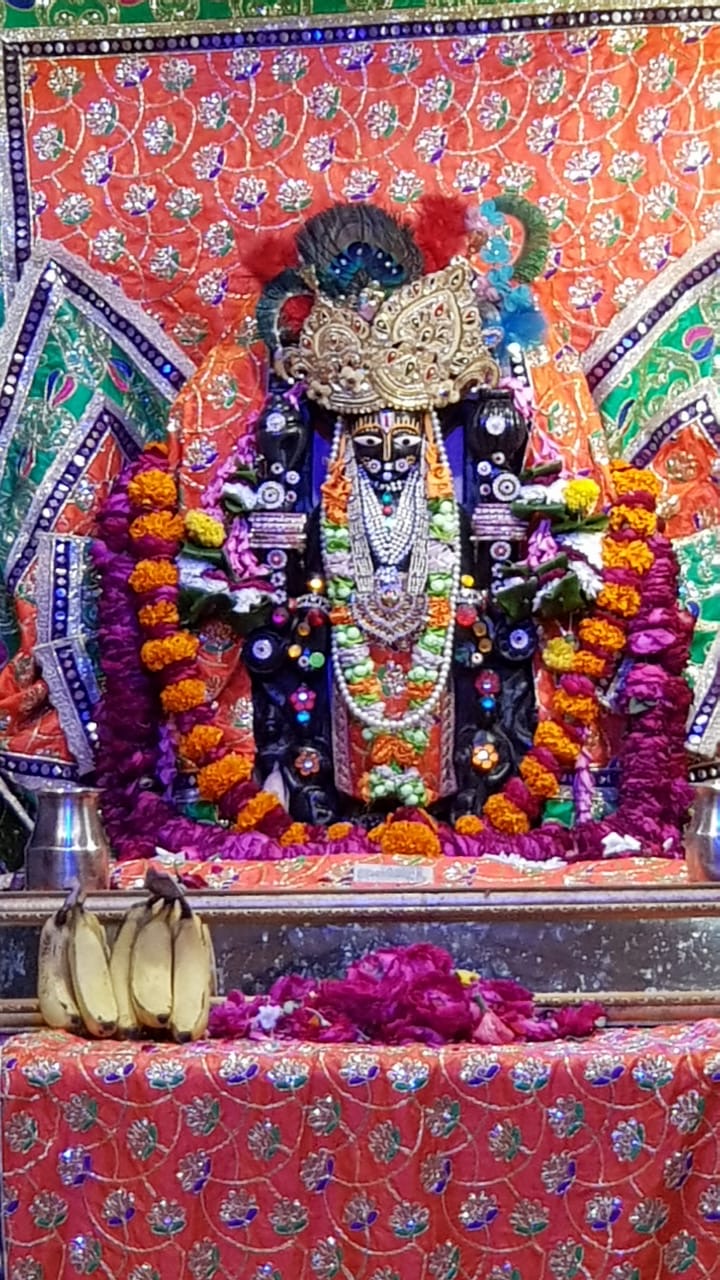Krishna Janmbhumi
Mathura
The Krishna Janmbhumi grounds are one of Mathura’s main draws as a pilgrimage site. The present complex is quite a sight – several temples are complemented by a large stage, two series of dioramas exhibiting Krishna’s divine exploits (one stationary, the other animatronic), a library, a bookstore, multiple tea and snacks kiosks, and over twenty souvenir shops. There is also a primary school and cow shelter onsite, though these are less visible to visitors. This array of structures is semi-recent – the Shri Krishna Janmbhumi Trust (est. Feb. 21, 1951) broke ground on October 15, 1953, with the imposing Bhagavat Bhawan finished on February 12, 1982.1
Although the administration is proud of having restored a temple destroyed by Aurangzeb in the seventeenth century, the historical significance of the site is tempered by three considerations. First, all of the deities in the complex are of recent provenance; to see the seventeenth-century murtī which occupied the historical temple, one must exit the complex from Gate-2 in order to visit the “Old Keshav Dev” Mandir. Second, if you happen to walk the city’s current circumambulation route (the Parikrama Marg), you will not be led to this complex but rather down the road past a much smaller temple courtyard. This modest grounds is the Kansa Prison Temple, tucked away on a neighborhood street, and claims to be the historical site of the prison cell where Krishna took birth. Third, and according to Heidi Pauwels, there is only uncertain evidence that the seventeenth-century temple was identified as the Krishna Janmbhumi Temple while it stood.2 Despite all of this, most visitors to the site today recognize it as Krishna’s birthplace and a significant pilgrimage destination.
Since 1991, there has been a permanent police presence at each entry point of the complex, as well as on each side of the major market street along the its southern boundary. This is due to the immediate proximity of the Krishna Janmsthan Complex to the Shahi Idgah as well as the threats following the destruction of Ayodhya’s Babri Masjid that Mathura would be next. Every local I spoke with assured me that the relations between the Muslim and Hindu communities in Mathura were amicable (barring the rare occasions when both communities host religious processions on the same day), and that no one wanted the demolition of the Shahi Idgah. In the words of my landlady during my residence in the city, “the birth shrine is already established – there wouldn’t be any point!”
There are two consequences to the permanent police presence that warrant further description. First, the traffic in the area is awful. Mathura’s Parikrama Marg winds its way around the Potra Kund, a large sandstone stepwell, on the western side of the Janmsthan Complex, and police barricades are occasionally erected during high influxes of pilgrims. Additionally, stick-wielding officers have a habit of preying on rickshaws bloated with passengers when they slow down in order to cross the railway tracks just outside the Janmsthan’s eastern boundary, further choking the already constricted road. The second consequence of the police presence is that no electronic items are permitted into the Janmsthan grounds. This makes for a significant change in the way people inhabit the space during visits; rather than competitions to take the best selfies or desperate attempts to make a phone call over the din of rushing pilgrims, the grounds of the Janmsthan complex force visitors to do so without this century’s favorite digital accessories. Only employees in the complex who possess a special identification card are permitted to bring their cell phones into the premises, and even then, only the upper-level administrators can carry the “smartphone” variety.
Brahma Kumaris Center
Quite nearby to the Krishna Janmsthan complex – just on the southern side of the Potra Kund – is the neighborhood Brahma Kumaris Center, which I have frequented in the course of my research. I have been repeatedly told that this is the “main” center of the Brahma Kumaris in Mathura, despite the fact that it did not appear as well-connected to the larger Brahma Kumaris institution as other local chapters.
For example, when I sought a way to officialize my participation in one of several conferences at the Brahma Kumaris headquarters at Mount Abu, Rajasthan, I tried, as is the norm, to do so through the local branch with which I am most closely affiliated. It is quite common for these local centers to organize group trips, designating “guides” who accompany first-timers so that their journeys will have minimal hiccups. When I asked Suman Didi, the in-charge of the Potra Kund center, to help me arrange my trip, she told me that the system for organizing group trips to Mount Abu was still in progress, and she recommended that I seek permission to attend from another Brahma Kumaris chapter. When I arrived at Mount Abu for the conference with approval from a New Delhi center, I was shocked to meet – completely by chance – the guide sent by Mathura’s Refinery Township Brahma Kumaris outlet. Though located on the periphery of Mathura proper, the Refinery Township branch appeared much better-connected to the event circuit of the Brahma Kumaris than the “central” Potra Kund location.


